Abstract
In food processing technology, the most used method is thermal processing. These methods reduce most essential qualities. Non-thermal reduces this loss. High-Pressure Processing (HPP) using 100 MPa to >1,000 MPa for short period and has been shown to enhance safety and extending shelf-life, free from additives with minimal influence on the sensory, physical, and nutritional properties of the food and minimizes the microorganisms to the safe level. It is applicable to foods with moisture with vacuum in flexible packaging. Salsa, organic juices, flavorful fruit smoothies, colorful applesauce, guacamole, purees, ready to eat meats are examples HPP makes possible. HPP inactivates oxidative enzymes and food pathogens. While reducing chemicals and other quality degrading processes, it extends shelf-life to more than twice than other methods. HPP treated RTE meat attain quality until 10 week while treated with standard process stay until fourth week. Antioxidant activity of strawberry and blackberry purees was reduced by 25% by thermal processing but there was only 5% reduction treated by HPP with better antioxidants and ascorbic acid retention. HPP treatment at 400, 600, and 900 MPa on different strains of meat product showed almost zero count of Listeria monocytogenes, Salmonella enterica, and S. aureus. A significant result was also found on total bacterial count on HPP treated fresh-cut Chinese with a result of 1.68log10CFU/g and 0logCFU/g for 400 and 600 MPa while there was a total population of 6.89 log10cfu/g and 6.18 log10cfu/g bacteria on control and treated with 200 MPa. A big effort is required on expanding this technology.
Keywords:
PUBLIC INTEREST STATEMENT
World population is facing different problems and lack of food is one of them. Beside the low production, there is also loss of food in different chain points as well as no or less accessibility of the food in different places and off-seasons. Due to temperature fluctuation, poor management, poor technology and infrastructure, lack of awareness, perishable nature etc, there is a huge qualitative and quantitative loss and produces cannot reach to the consumer properly. Technologies, like processing and preservation techniques, play a vital role in minimizing this problem and make food stay longer with their constituent and make food available in time of need. High-pressure processing maintains most of the food constituent and increase shelf-life of the food by avoiding and killing MOs without affecting the constituents. Its principles can be used in different technologies and used throughout the world for food preservation and processing regardless of its cost.
Competing Interests
The author declares no competing interests.
1. Introduction
It is generally estimated that over 25% of what we produce is wasted in the post-harvest chain and never reaches the consumer’s pot. Wastage of food represents an economic loss as well as food insecurity. But the loss is greater if exact assessment is done in every chain for each product type (Ramaswamy & Tessema, Citation2010). Liplap, Vigneault, Rennie, Boutin, and Raghavan (Citation2013) strengthens the idea that postharvest losses between harvest and consumption can be as high as 40% or even higher in some developing countries. Many Factors lead food not to reach to our fork. Enzymes present in very small amounts in all living material that can put all living activities under their control; continue to function after harvest, causing a natural breakdown of fresh produce (Ramaswamy & Tessema, Citation2010). Chemical and enzyme spoilage occurs especially when the foods are exposed to external factor that leads to release enzymes that trigger chemical reactions (James & Kuipers, Citation2003). Food products are an excellent environment for growth of pathogenic microorganisms, which may cause food-borne diseases. Quality and shelf-life of food products depend greatly on the properties of microorganisms contaminating the food (Fonberg-Broczek et al., Citation2005).
Table 1. Comparison of different processing technologies
Table 2. Analysis of fresh-cut Chinese yam after 9 days of storage at 4°C
Table 3. Antioxidant indices of thermally and HPP strawberry and blackberry purées
Table 4. Effect of UHP on total bacterial counts in fresh-cut Chinese Yam (Log10CFU/g)
Table 5. Counts of Listeria monocytogenes, Salmonella enterica, and Staphylococcus aureus (log CFU/ml ± SD) before and after HP treatment at 400, 600, and 900 MPa
Figure 6. Shelf-life extension of Artichoke parmesan dip by HPP (pH 4.72).
Source: Avure Technologies Inc (Citation2009).
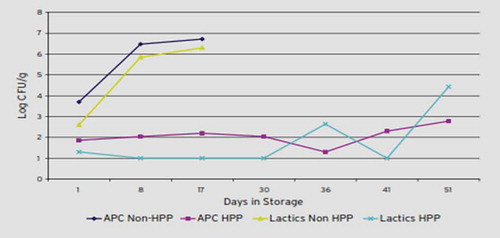
Figure 7. RTE meat and poultry -sensory and quality attributes.
Source: Sharma (Citation2011).
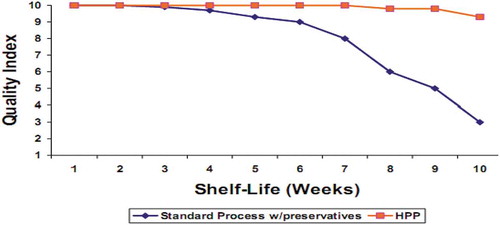
Figure 8. A typical time and temperature profile of strawberry purées processed at different pressure treatments.
Source: Patras et al. (Citation2009b).
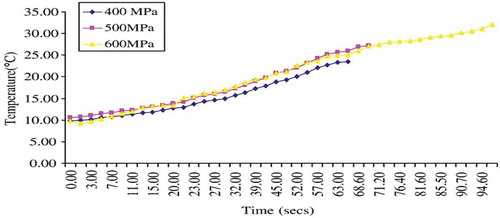
Figure 9. Inactivation of orange juice pectinesterase, PE at 600, 700, 800, and 900 MPa pressure for three dwell times.
Source: Goodner et al. (Citation1998).
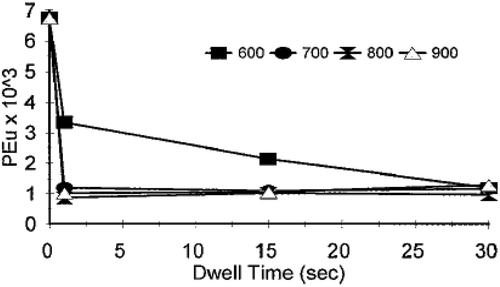
Figure 10. The number of Saccharomyces cerevisiae at different pressures after treatment for 15 min at 50°C (A), and The number of Saccharomyces cerevisiae at different pressures after treatment for 15 min at 30°C (B).
Source: Kuldiloke and Eshtiaghi (Citation2008).
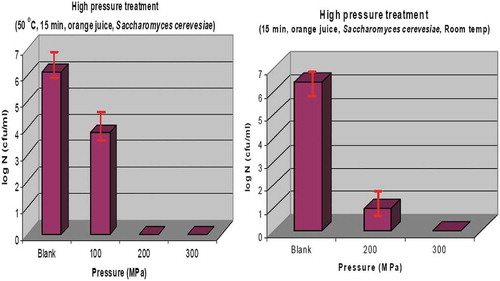
Figure 11. Effect of various pretreatments on the rehydration rate of dehydrated sweet potato.
Source: Abe et al. (Citation2011).
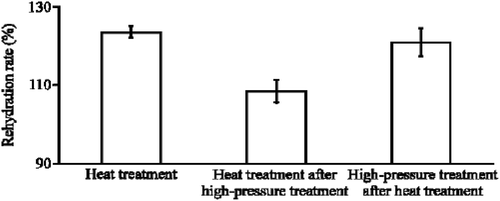
Figure 12. Relative hardness of rehydrated sweet potato exposed to various pretreatments.
Source: Abe et al. (Citation2011).
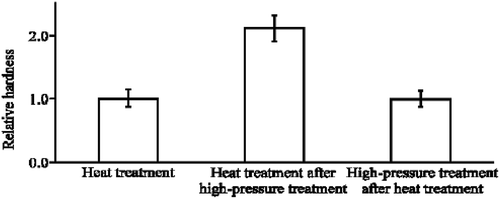
Figure 13. Effect of high-pressure treatment (200–600 MPa for 20 min) on percentage cell rupture in cherry tomatoes.
Source: Tangwongchai et al. (Citation2000).
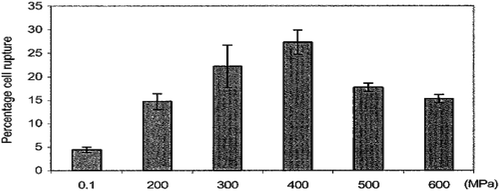
However, as food deterioration is constant threat along the entire food chain, food preservation remains as necessary today as in the past (Yaldagard, Mortazavi, & Tabatabaie, Citation2008). The product nature and some other external factors including methods applied during the processing together with the environmental condition cause loss of the quality and quantity of the food component. This trend has resulted, for many food products, in changes in formulation and processing, which may previously have limited microbial growth (Murchie et al., Citation2005).
To make food available throughout the year, man has developed methods to prolong the storage life of products: to preserve them. The rotting process can be postponed by adding preservatives, optimizing storage conditions, or applying modern techniques (James & Kuipers, Citation2003; Ramaswamy & Tessema, Citation2010). The nutritional value of most food is highest when they are fresh, but it is not always possible to consume them immediately. In most countries, the production of many perishable food crops is seasonal, making them available only during short periods of the year. During this short time, they are produced in greater quantity than the market can absorb, so the surplus of many of these crops must be processed and preserved to avoid wastage of the food and loss of income to the grower (James & Kuipers, Citation2003). One way to make the food available as farm-fresh state for later use in distant markets is to convert them into more stable form. Thus, the major emphasis of food processing is preservation or shelf-life extension by preventing undesirable changes in the wholesomeness, nutritive value and sensory qualities by controlling chemical, biochemical, physiological and microbiological activities (Ramaswamy & Tessema, Citation2010). Demand for fresh food products has increased dramatically in recent years, due to consumer awareness and concerns towards health and healthy foods (Ramaswamy, Zaman, & Smith, Citation2008). Recently, a booming market for nutraceuticals and functional beverages in Asia, as well as price cuts for vitamins, minerals and pharmaceutical products in China, has led to the increased trends in food fortification (Adzahan & Benchamaporn, Citation2007).
Consumers have a growing preference for natural and fresh tasting (Karim, Citation2011), convenient, healthy, palatable, microbiologically safe (Yaldagard et al., Citation2008), high quality, free from preservatives and additives foods (Karim, Citation2011; Yaldagard et al., Citation2008) with a clean label and an extended shelf life has increased (Karim, Citation2011). To retain the desired quality of a product longer than if it were simply stored after harvesting and improperly prepared, it must be preserved. To preserve food it must first be treated, with the goal of stopping physiological aging and enzyme changes and preventing the growth of micro-organisms (James & Kuipers, Citation2003). Nowadays, new processing technologies are needed to deliver products in compliance with requirements, while maintaining other main quality attributes such as nutritive and sensory properties (Daher, Le Gourrierec, & Pérez-Lamela, Citation2017). Some of the Various techniques, which can be adopted for preserving and converting the foods to other stable forms, are dehydration, addition/removal of heat, preserving with salt, sugar, addition of preservatives like vinegar, deep-freezing, chemical preservation (Ramaswamy & Tessema, Citation2010).
One of the main concerns in the food process industry is also the survival and growth of pathogens, causing bacterial spoilage and human infections, and affecting the health and safety of consumers (Daher et al., Citation2017). Thermal treatment of foods is done in the food industry for preservation purposes. It has most of the characteristics of an ideal food preservation method. Food preservation prevents deteriorative reactions, extends a food’s shelf life and assures its safety (Chipurura & Muchuweti, Citation2010). It is a primary method for food pasteurization and sterilization (Balasubramaniam & Farkas, Citation2008). It has been well recognized for preparing long term shelf-stable food products (Ramaswamy et al., Citation2008).
This processing traditionally used in the food industry induces undesirable and unavoidable adverse effect on some of the nutrients and the overall quality changes of food such as loss of smell, color, flavor, texture and nutritional value and it has been the topic of discussion for optimization procedures (Balasubramaniam & Farkas, Citation2008; Queiroz et al., Citation2010; Ramaswamy et al., Citation2008). And, however, in some foods the high thermo-tolerance of certain enzymes and microorganisms, mainly bacteria spores, entails the application of extreme heat treatments, which changes the nutritional, phytochemical and organoleptic food properties (Chipurura & Muchuweti, Citation2010).
Despite the extensive knowledge in food preservation by heat treatment and continued attempts to improve the quality of processed, food there is still a need for technologies that minimize the destructive influence of heat on valuable food compounds (Särkkä-Tirkkonen, Hanna-Maija, & Beck, Citation2010). Reduction in the severity of thermal processing and introduction of new concepts in food preservation methods which would have minimal effects on functional properties are continuously being explored to cope with such demands and different non-thermal processes such as high pressure processing (HPP), pulsed electric fields (PEF), irradiation and ultra-filtration, as alternative techniques to conventional thermal treatment (Ramaswamy et al., Citation2008).
The food industry has responded by applying a number of new technologies including high hydrostatic pressure for food processing and preservation (Yaldagard et al., Citation2008) and among the new technologies, HPP has the most promise, especially in reducing spoilage caused by microorganisms and enzymes, while maintaining nutritional quality of foods. Rupture of bacterial cells due to pressurization and depressurization is considered to be the main cause for destruction of microorganisms under different pressure regimes (Ramaswamy et al., Citation2008). It was one of those treatments that was applied in the food industry at the end of the 80s, is based on the application of high pressure into jams, fruit jellies, sauces, and fruit juices (Daher et al., Citation2017). The objective of this paper was to review on the high-pressure processing and its effect on food quality, shelf-life, microbial and enzyme inactivation and other parameters.
2. Literature review
High-pressure processing (HPP) is a non-thermal technology capable of producing high-quality foods, maintaining the characteristics of fresh products and extending shelf life (Queiroz et al., Citation2010). It is a cold pasteurization technology by which products, already sealed in their final package, are introduced to a vessel and subjected to a high level of isostatic pressure (300–600 MPa). High-pressure food preservation refers to high pressure used for food preservation. “Pressed inside a vessel exerting high pressure, food can be processed so that it retains its fresh appearance, flavor, texture and nutrients while disabling harmful microorganisms and slowing spoilage (Xu, Citation2005).
As pressure is commonly transmitted by the water contained inside the HPP chamber, the technology is also referred to as high hydrostatic pressure HHP, which got its start over a century ago, is finally reaching the point where it can be commercially applied on a large scale. The technology subjects foods, which can be liquid or solid, packaged or unpackaged, to pressures between 40,000 and 80,000 pounds/square inch (psi), usually for 5 min or less (Flick, Citation2003; IUFoST, Citation2010), 100–800 MPa and the temperature during pressure treatment can vary from below 0 to above 100°C (Queiroz et al., Citation2010; Ramaswamy et al., Citation2008), with short holding times to process or pasteurize different foods (Ramaswamy et al., Citation2008), to a pressure range of 300–600 MPa. Exposure times can range from a few seconds to over 20 min, depending on the objective of the treatment (Queiroz et al., Citation2010). Pressure is evenly and instantaneously transmitted throughout the sample, which provides products without over treated parts (Queiroz et al., Citation2010; Ramaswamy et al., Citation2008).
According to Bertucco and Vetter (Citation2001), HPP was used in different industries for different purposes such as; in the Production of Polyethylene (PE): The different available high pressure polymerization processes of polyethylene (PE) yield LDPE (low density PE), LLDPE (linear low density PE) and copolymer features of the same. Production of unsaturated fatty alcohols: This hydrogenation process is, among others, the basis for the production of washing detergents. Decaffeination of coffee beans: Of the various extractions processes the decaffeination with supercritical CO2 exhibits the most commercial advantages for bulk production. Homogenization of milk and other foodstuffs: Liquid foodstuffs, for example, milk products must be submitted to homogenization treatment in order to improve their long-term physical stability (“shelf life”). The liquid is pumped at very high pressure by a multiplex reciprocating piston pump through the narrow clearances of a hydraulically controlled homogenization valve. The sterilization of fruit juices with high pressure: This method for the aseptic processing of foodstuffs and other organic products still appears to be some way from extended application. Example HP sterilization of fruit juices with pulp contents, the high-pressure sterilization offers valuable advantages with respect to the quality of the final product compared to other sterilization procedures, especially if natural fractions of fruit pulp are desire.
In HPP, the application of pressure can be accomplished uniformly throughout the food independent of size, shape and food composition (Ramaswamy et al., Citation2008). HPP is one of the emerging technologies to be studied as an alternative to classical thermal processing of food. This “clean” technology offers an effective and safe method of modifying protein structure, enzyme inactivation, and formation of chemical compounds. In addition, the study of the effects of high pressure on biological materials has received a great deal of attention in recent years. During the last decade, numerous publications that describe the influence of pressure on various constituents and contaminants of foods such as spoilage microorganisms, food pathogens, enzymes and food proteins have appeared in the literature (Yaldagard et al., Citation2008). The leading countries using HPP are the South America, Europe, Asian country and the biggest food product (by revenue) processed by HPP is ready to eat meat but the fastest growing is Deli Salads, Dips, Salsas markets (Howson, Citation2009; IUFoST, Citation2010).
High-pressure processing is increasingly being used in the commercial processing of oysters, due to its minimal effects on sensory and nutritional quality, the opening or shucking of oysters during treatment, and the reduction of levels of Vibrio vulnificus, a pathogen of concern particularly in the US (Murchie et al., Citation2005).
2.1. High-pressure processing and its principles
2.1.1. Concept and importance
Over the last few years, consumption of processed fruits and vegetables has increased and there is convincing epidemiological evidence that consumption of fruits and vegetables is in general beneficial to health because of their high source of phytochemical substances (Chipurura & Muchuweti, Citation2010). According to Karim (Citation2011), two main principles control the behavior of food under high pressure: Le Chatelier’s Principle which says phenomena resulting in a decrease in volume, like phase transition, chemical reaction, or change in molecular configuration, that are enhanced by pressure. On the contrary, phenomena resulting in an increased volume are slowed down by pressure and in Isostatic Principle (Figure ), Pressure is instantaneously and uniformly transmitted throughout the sample, independently of size and shape of the food, which is a major advantage compared to thermal processing. A uniform pressure will be applied uniformly in all directions of the sample, thus the pressure will not damage the product which will return to its original shape when the pressure, known as isostatic pressure, has been released. The basic procedure and knowing how HPP works, it is best found to put the principle explained by Howson (Citation2009) vice president of world marketing of Averue Technologies.
HPP uses a product in its final form of packaging so the big advantage is that the product is not going to be touched by human hand after it is packaged. Its post package process, we load the package into final baskets and those baskets are loaded on a vessel/chamber. Baskets are pushed into the vessel in it fills with water. Once the water is surrounded the baskets/packages, we pump-up that up to 87,000 psi/6,000 bar/600 MPa that is 5–6 times deeper from the deepest Ocean (Howson, Citation2009; Sharma, Citation2011). HPP application results in an instantaneous and uniform transmission of the pressure throughout the product and is independent of the product size and geometry (Ramirez-Suarez & Morrissey, Citation2006). This technique can inactivate microorganisms and enzymes, prolonging food shelf life with minimal effects on nutritive and organoleptic quality (Daher et al., Citation2017).
High-pressure technology acts instantaneously and uniformly throughout a mass of food independent of size, shape and food composition. Compression will uniformly increase the temperature of foods approximately 30°C per 100 MPa. The temperature of homogenous food will increase uniformly due to compression. An increase in food temperature above room temperature and to a lesser extent a decrease below room temperature increases the inactivation rate of microorganisms during HPT treatment. Temperatures in the range of 45–50°C appear to increase the rate of inactivation of food −1100°C in conjunction with pressure 500–700 MPa have been used to inactivate spore-forming bacteria such as Clostridium botulinum (Kadam, Jadhav, Salve, & Machewad, Citation2012).
Because the product is getting pressure from everywhere, it cannot change shape. E.g. if we take a Grape in our hand and press it, we make juice because of that pressure. And if we take the same Grape and put it in a bottle of water and we fill it up with water and put a lid on it and squeeze it as hard as we can, we can have that Grape. Nothing change in shape because it is getting pressure all the way around it and all the way through it, it cannot change shape (Howson, Citation2009) (Figure ). So, the only way it happens are we squeeze the life out of food pathogens/microorganisms like E. coli, Lesteria, Salmonella…, yeast, mold spoilage organisms that is actually the process her where just using very high water pressure to squeeze the life out of this organisms. So, rupturing of cell considered to be the main cause for destruction of microorganisms under different pressure regimes (Howson, Citation2009; Ramaswamy et al., Citation2008; Yaldagard et al., Citation2008). So, when one step is done, technically we would have 1–3 min all time depending on the product. The vessel then drains of water which of course is completely filters and reused to the next round and the basket slides down and dried and sent to pack up for putting them on carton (Howson, Citation2009).
High-pressure processing has been known for more than a century as a food preservation method. High-pressure technology has also been applied for years in industries to process ceramic products, carbon graphite, composite materials and plastics. This technology is gaining popularity because of its ability to offer superior quality products as compared to conventional thermal processing and other methods (Table ); however, commercial applications have emerged only recently (Ramaswamy et al., Citation2008). The absence of heat in this technology (Adzahan and Benchamaporn, Citation2007) offer some advantages such as the sensory and nutritional (Adzahan and Benchamaporn, Citation2007; Abe et al., Citation2011; Flick, Citation2003) attributes of the product remaining unaffected, thus yielding products with better quality compared to traditional processing methods (Adzahan and Benchamaporn, Citation2007). HHP offers reduced process times; reduced physical and chemical changes; retention of freshness, flavor, texture, appearance, and color; elimination of vitamin C loss; reduced ice crystal damage; and reduced functionality alterations compared to traditional thermal processing (Avure Technologies Inc, Citation2007; Flick, Citation2003).
It can be used, for example, as a means to accomplish non-thermal treatment of raw or fresh oysters, reducing bacterial loads without causing significant changes in appearance, flavor, texture, and nutritional qualities (Flick, Citation2003).
2.1.2. Conditions to be considered in HPP
The food product to be treated at high pressure is packaged in a flexible container and placed inside a pressure vessel submerged in liquid medium (mostly water), which transmits the pressure (Gopal, Kalla, & Srikanth, Citation2017). The equipment used in HPP consists, a different volume capacity chamber for holding the HPP fluid and samples (Avure Technologies Inc, Citation2008). The primary components of an HPP system include a pressure vessel; closures for sealing the vessel; a device for holding the closures in place while the vessel is under pressure (e.g., yoke); high-pressure intensifier pumps; a system for controlling and monitoring the pressure and (optionally) temperature, and a product handling system for transferring product to and from the pressure vessel. Normally, perforated baskets are used to insert and remove pre-packaged food products from the pressure vessels. Systems also have provisions for filtering and reusing the compression fluid (usually water or a food-grade solution) (Figures and ) (Gopal et al., Citation2017).
Consumers require safe food, but increasingly they also demand minimally processed, additive-free foods with an extended shelf-life (Murchie et al., Citation2005). Sharma (Citation2011), try to differentiate foods suitable and unsuitable for HPP. Foods that are suitable for HPP includes, low-medium moisture, semi-solid/solid foods, vacuum packaged (example Dry-cured or cooked meat products Cheeses, Fish, seafood, marinated products, Ready to eat meals, sauces), High moisture, solid foods, vacuum packaged (example Fruits, marmalades/jams Vegetables), High moisture, liquid foods in plastic bottle/flexible packaging (such as Dairy products, Fruit juices, Bioactive beverages) and those Foods unsuitable for HPP includes; Solid foods with air included (like, Bread and cakes and Mousse), Packaged foods in completely rigid packaging (example Glass packaging and canned foods) and Foods with a very low water content (such as Spices, Dry fruits and Powders). Figure shows different pressure requirements for different food type. It shows low acid foods need lower pressure to process (Raghubeer, Citation2015).
2.2. HPP application and its effect on some food product and their quality
2.2.1. Effect of HPP on shelf life of food
Basak and Ramaswamy (Citation1998), mentioning Hite and his colleagues’ early report studies in 1914, that HP processed fruits could be preserved for nearly 5 years following the pressure treatment. Macaroni salad with vegetables (pH 4.83) had a shelf-life of 3 days. High pressure processed (HPP) samples of this product were microbiologically stable for more than 40 days following treatment with good sensory properties throughout the shelf-life. Conversely, the level of spoilage microorganisms in the non-HPP samples increased sharply with notable deterioration of quality. Similar results were obtained for Old Fashioned Potato salad with chemical preservatives, pH 4.97, Cashew Chicken salad, pH 5.4, and homemade Chicken Potato Salad with eggs, pH 5.4 (Avure Technologies Inc, Citation2009).
The effects of high-pressure processing (300 and 600 MPa for 1 min) on sensory quality and stability of mango cubes kept for up to 9 weeks at 3°C was evaluated. Fresh mango flavor declined and off-flavor increased during storage, but color and other sensory attributes changed very little. They also found that high pressure prevented increases in microbial load that was noted in the control (Kader, Citation2008).
Two dips were evaluated, Spinach, pH 4.93 with a shelf-life of 7 days, and Artichoke Parmesan, pH 4.72 with a 14-day shelf-life (Figure ). The shelf-life of both products increased to more than 50 days following HPP with good sensory properties throughout the evaluation. The non-HPP samples spoiled early into the shelf-life with high microbial levels and deterioration in organoleptic markers (Avure Technologies Inc, Citation2009).
Orange juice pressurized at 700 MPa for 1 min had no cloud loss for >50 days (Goodner, Braddock, & Parish, Citation1998). The effects of HPP on contents of total soluble solids, titratable acidity and ascorbic acid of fresh-cut Chinese yam was studied and it was found that all the samples treated with UHP had higher total soluble solids, titratable acidity and ascorbic acid than that one untreated samples (Table ). This could be related to the loss of water during processing and/or solubilization of previously insoluble materials. A small amount of fluid was seen in the UHP treated samples (Guangjie & Bo, Citation2000).
After 9 days of storage, the total soluble solids reduced from 16.4% to 14.8% in samples of treated with 200 MPa and from 15.8% to 13.2% in the untreated samples. However, there was no significant decrease in samples treated with 400 MPa and 600 MPa in storage. Samples treated with 200 MPa had significantly higher titratable acidity (P < 0.05) and lower ascorbic acid compare to control. However, there were no significant change in titratable acidity and ascorbic acid in samples treated at 400 MPa and 600 MPa compared to the control. This can be probably explained by the sterilization effect of UHP. As previous, more than 400 MPa pressure already yielded a microbiologically stable product. This observation could also be linked with the effect of UHP on enzyme activity. The inhibition of the microorganisms, physiological quality demonstrated here suggested that application of UHP 600 MPa could effectively in extend the shelf life and maintaining quality of fresh-cut Chinese yam slices during storage (Guangjie & Bo, Citation2000).
The result shown below in the figure is done to evaluate the effect of HPP treatment on ready to eat meat and its sensory attributes (Sharma, Citation2011).
The standard process with preservatives and HPP kept the food until the third week, and the standard method treated meat declines in its quality but the HPP treated meat attains its quality until the tenth week (Sharma, Citation2011).
A study conducted by Hayman, Baxter, O’Riordan, and Stewart (Citation2004) on Ready to eat (RTE) meats (low-fat pastrami, Strassburg beef, export sausage and Cajun beef) pressured treated at 600 MPa, 20°C for 180 s to evaluate the feasibility of using HPP for the safe shelf-life extension of the products showed that HPP at 600 MPa, 20°C, for 180 s can extend the refrigerated shelf life of RTE meats and reduce L. monocytogenes numbers by more than 4 log CFU/g in inoculated product. RTE meat and poultry -sensory and quality attributes were studied by Sharma, Citation2011 (Figure ) showed a good result that the shelf-life of the meat stayed with its quality until the tenth week.
2.2.2. Physicochemical effects of HPP
Effects of HPP on food color & flavor was summarized by Sharma (Citation2011). In fresh or marinated meat, the iron in the myoglobin changes from ferrous to ferric and globin is denatured then the red color is lost but the cooked meat color is largely unaffected same as with that of cooked meals. In Fruits and vegetables there will be slight modification but in fruit juices there is a little or no effect and flavors are mostly unaffected. The effect of UHP on browning index, and disease incidence of fresh-cut Chinese yam were shown and appearance loss was the main factor that limited the shelf life of fresh-cut Chinese yam, similar to other minimally processed fruits and vegetables. Fresh-cut Chinese yam quickly lost its white color even stored at low temperature. Browning spots appeared after 3 days of storage and became obvious after 6 days at 4 (browning index °C > 2.0). After 9 days of storage, the initial bright color of the control fresh-cut Chinese yam had largely disappeared, and about 22% of the slices began to rot. Compared to the control, the slices treated with 400 MPa have no disease development but has more serious color browning. Slices treated with UHP 600 MPa remained a bright color and no disease development was observed until the end of storage (Guangjie & Bo, Citation2000). Traditional thermal treatments did not exert any effect on total carotenoid content or vitamin A value in orange juice. With respect to flavanones, HP treatment led to increased (P < 0.05) naringenin (20.16%) and hesperetin (39.88%) contents, whereas pulsed electric fields (PEF) treatment did not modify individual or total carotenoids content and flavanone content (Moreno, Plaza, DeAncos, Martin, & Cano, Citation2005).
Strawberry purée treated by the conventional thermal process had an ascorbic acid content of 496.1 mg/100 g DW representing an overall significant decrease of 22.6% (p < 0.05). In fact, ascorbic acid levels were significantly higher for all high pressure treated samples as compared to conventional thermal processed samples (p < 0.05), results indicate that pressurization at 600 MPa preserved the majority of the ascorbic acid in the samples (94%). A high pressure treatment of 500 MPa, at 35°C for 5 min led to better retention of ascorbic acid during processing as compared to conventional thermal pasteurization (80°C, 30 s) for orange juice. Ascorbic acid levels in blackberry samples were not detectable. Antioxidant activities are expressed as anti-radical powers (ARP), the inverse of the IC50 index which gives a more convenient illustration of radical scavenging activity as it is directly related to it. Higher ARP values for blackberry purées were presumably related to higher phenolics and anthocyanin levels. Unprocessed strawberry and thermally treated purées had anti-radical powers of 1.55 and 1.16 (g/L)−1 respectively representing an overall significant decrease of 25% (p < 0.05) during processing. For strawberry purées high pressure treated samples at 400 MPa had significantly lower antioxidant capacities when compared to unprocessed samples (p < 0.05). However, for purées treated at 500 and 600 MPa, mean ARP values were higher than thermally processed samples (p < 0.05). In contrast, for blackberry purées no significant differences in ARP values were detected between unprocessed, thermally processed, HPP400 or HPP500 whereas pressure treatments at 600 MPa produced significant increase of 67% as compared to unprocessed counterpart. The possible reason for the increase in ARP could be due to better extractability of antioxidant components (Patras, Brunton, Da Pieve, & Butler, Citation2009b). Other authors have also reported that high-pressure processing either increase or do not affect antioxidant activity of liquid foods (Moreno et al., Citation2005).
Phenolic content
Phenols appeared to be relatively resistant to the effect of processing. Effect of HPP treatment was applied on strawberry and blackberry purees was studied (Patras, Brunton, Da Pieve, Butler, & Downey, Citation2009a). The study was also done on cashew-apple juice to evaluate the impact of high-pressure processing (HPP) at room temperature (25°C) on the fruit juice phenolic compound and ascorbic acid contents and antioxidant capacity, a fruit native to Brazil (Queiroz et al., Citation2010). Levels of phenols in high pressure treated strawberry purées treated at 600 MPa (939.0 mg/100 g DW) increased significantly (9.8%, p < 0.05) as compared to unprocessed purée (855.0 mg/100 g DW). Similar trend was observed for blackberry purées. This increase in total phenolic content may be related to an increased extractability of some of the antioxidant components following high-pressure processing (Patras et al., Citation2009b).
The study on cashew-apple juice showed that HPP at 250 or 400 MPa for 3, 5 and 7 min did not change pH, acidity, total soluble solids, ascorbic acid or hydrolysable polyphenol contents. However, juice pressurized for 3 and 5 min showed higher soluble polyphenol contents. Antioxidant capacity, measured by the ferric reducing antioxidant power method, was not altered by HPP, but when treated at 250 MPa for 3 min, it resulted in an increased value when 2, 2-diphenyl-1-picrylhydrazyl was used. HPP can be used in the food industry for the generation of products with higher nutritional quality (Queiroz et al., Citation2010). No significant differences were detected on phenolic concentration after thermal treatments. Pressure treatment at 400 and 500 MPa produced a slight but non-significant increase on total phenolic content. For blackberry purées neither high pressure (400 MPa) nor thermal processing had a significant effect on levels of phenols. Similar to the case for strawberry purées, levels of phenols were significantly higher at 600 MPa or 500 MPa than all other treatments. This increase in total phenolic content is with the reason similar to that of strawberry, be related to an increased extractability of some of the antioxidant components following high-pressure processing (p < 0.05) (Patras et al., Citation2009b) (Figure ).
Anthocyanin content
The main anthocyanin present in strawberry purée is Pelargonidin- 3-glucoside (Pg3gl). Pg3gl contents of unprocessed and thermally processed purées were 202.27 and 145.82 mg/100 g DW with an overall significant reduction of (27.9%, p < 0.05). Degradation of anthocyanin pigments in strawberry purée may have been catalyzed by the presence of oxidase enzymes during or after processing. No significant difference between levels of Pg3gl in high pressure treated samples was detected for strawberry purées regardless of pressure level (p > 0.05). The main anthocyanin present in blackberry purée is cyanindin-3-glycoside (Cy3gl), ranged from 975.28 to 1039.21 mg/100g DW. The sample subjected to conventional thermal treatment, levels of Cy3gl in thermally processed blackberry purée were significantly lower than for unprocessed sample (p < 0.05). This decrease could be due to simple thermal degradation of the samples although the thermal treatment was relatively short (70°C, 2 min) (Table ). However, anthocyanin degradation in processed berry products has been reported to arise as a result of indirect oxidation by phenolic quinones generated by polyphenol oxidase and peroxidase. Anthocyanins are stable to HP treatment at moderate Temperature some authors have also reported increased extractability of colored pigments in food components at extreme pressures (Patras et al., Citation2009b; Wang & Xu, Citation2007).
Antioxidant activity (ARP), ascorbic acid, and carotenoids after exposure to high-pressure treatments (400–600 MPa/15 min/20°C) were well retained. Redness and color intensity of purees were better preserved by HPP than conventional thermal treatment (70°C/2 min). Antioxidant activity in tomato and carrot puree was significantly higher (p < 0.05) than in untreated or thermally processed samples. HP treatments at 600 MPa retained more than 90% of ascorbic acid as compared to thermal processing in tomato purees. Heat treatments caused a rapid decrease in ascorbic acid (p < 0.05). Phenolic contents were in general unaffected by thermal or HP treatments. Color parameters were significantly affected (p < 0.05) by thermal and high and HPP. Principal component Analysis (PCA) revealed that the first two components represented 97% and 92% of the total variability in instrumental color parameters with respect to processing for tomatoes and carrots, respectively (Patras et al., Citation2009a).
Bioactive compounds (cyanidin-3- glycoside, pelargonidin-3-glucoside, ascorbic acid) and antioxidant activity were measured in strawberry and blackberry purées subjected to high-pressure treatment (400, 500, 600 MPa/15 min/10–30°C) and thermal treatments (70°C/2 min). In general, antioxidant activities of pressure treated strawberry and blackberry purées were significantly higher (p < 0.05) than in thermally processed samples. Color changes were minor for pressurized purées, but the differences were slightly higher for thermally treated samples. Redness of purées was well retained in high pressure treated samples. Therefore, processing strawberry and blackberry by high-pressure processing could be an efficient method to preserve these products quality. Hence, high-pressure processing (HPP) at moderate temperatures may be appropriate to produce nutritious and fresh like purées (Patras et al., Citation2009b).
2.2.3. Effect of HPP against microorganisms and enzymes
One of the main applications of high-pressure processing in food technology is to use it as a preservation method to destruct of microorganisms and inactivate enzymes in the food products while preserving quality-related factors (vitamins, pigments, and flavor components) (Heinz & Buckow, Citation2009; Ramaswamy et al., Citation2008). HPP is used in the food industry to enhance the safety and extend the shelf-life of food (Jofré, Aymerich, Bover-Cid, & Garriga, Citation2010). In the last years, an increasing interest has been drawn in temperature uniformity of high-pressure processes (Otero, Ramos, de Elvira, & Sanz, Citation2007; Ramaswamy et al., Citation2008).
High pressure directly affects cellular physiology of the microorganisms. High pressure of a few 100 MPa can decrease the viability of bacterial cells, and a pressure of a few tens MPa can decrease the growth rate. The inactivation is due to widespread damages of micro-organisms through modification of morphology and of several vulnerable components such as cell membranes, ribosomes, and enzymes, including those involved in the replication and transcriptions of DNA (Pal & Devrani, Citation2018)
Although a drastic decrease in microbial viability is achieved immediately after the application of HP treatments, under favorable conditions the injured bacteria can recover (Jofré et al., Citation2010). Filleted fish were made into slurry with peptone water and inoculated with the respective microbial strain to prepare a stock culture containing 106–107CFU/ml. samples were prepared for pressure treatment by heat-sealing 10 ml portions of stock culture in sterile plastic bags. Pressure treatments (250 and 400 MPa for 0–60 min) were given at room temperature (20–25°C) in an isostatic press. Survival curves were established based on residual counts following treatment. Destruction kinetics were described as a dual effect, an initial destruction resulting from a pressure pulse (pulse effect) followed by a first order rate of destruction during the pressure holding time. E. coli was found to be more sensitive to pulse pressure than L. monocytogenes. Significant differences (p < 0.05) in high-pressure resistance (D-value) were found between the two microorganisms. D-values of E. coli were higher than for L. monocytogenes at pressure levels≥350 MPa, while a reverse trend was observed at low pressures. Challenge studies with the more resistance pathogen, E. coli (107/ml), showed that a 10D treatment followed by refrigerated storage (4–12°C) prevented its recovery (Ramaswamy et al., Citation2008).
Goodner et al. (Citation1998) explored the use of pressurized treatments of orange and grapefruit juices to bypass the use of extreme heat during processing (Figure ). Pressurization process inactivates Pectinesterase (PE), also called pectase (an enzyme found in certain plants, bacteria and fungi that catalyzes the hydrolysis of pectin to pectic acid and methanol which also reduces the quality of citrus juice) inactivation using isostatic high pressure in the range of 500–900 MPa was accomplished in orange and grapefruit juices.
Current inactivation of the enzyme is accomplished by heat, resulting in a loss of fresh fruit flavor in the juice. The higher pressures (>600 MPa) caused instantaneous inactivation of the heat labile form of the enzyme but did not inactivate the heat stable form of PE. Treatment times caused significantly different (α = 0.05) total PE activity losses in orange but not in grapefruit juices, and PE inactivation at different pressures was significantly different in both juices. Heat-labile grapefruit PE was also more sensitive than orange to pressure (Goodner et al., Citation1998).
The effects of high-pressure processing (300 and 600 MPa for 1 min) on sensory quality and stability of mango cubes kept for up to 9 weeks at 3 C was evaluated. Fresh mango flavor declined and off-flavor increased during storage, but color and other sensory attributes changed very little. They also found that high pressure prevented increases in microbial load that were noted in the control (Kader, Citation2008).
The effect of HPP on the number of bacteria of fresh cut Chinese yam is found that the number of bacteria of fresh-cut Chinese yam treated with UHP was decreased with increasing pressure of HP before storage. Total bacterial counts on fresh-cut Chinese yam treated with UHP were also significantly lower (P < 0.05) than those of non-treated ones during storage at 40 C for 9 days. UHP of 400 MPa was able to reduce the number of bacteria on fresh-cut Chinese yam by 4.42log10CFU/g before storage. In addition, the numbers of total bacteria were increased as storage time increased. On the ninth day of storage, the population of total bacteria on the fresh cut Chinese yam non-treated and treated with 200 MPa reached for 6.89 log10cfu/g and 6.18 log10cfu/g, respectively, which resulted in the spoilage of tissue. However, the total bacteria count on fresh-cut Chinese yam treated with 400 MPa and 600 MPa were 1.68log10CFU/g and 0log10CFU/g, respectively (Guangjie & Bo, Citation2000) (Table ).
HPP has been investigated for the cold pasteurization of fruit and vegetable product and has significant microbial inactivation. UHP treatment of 350 MPa for 30 min can produce a five logarithmic unit reduction in viable vegetative cells. However, many other factors have the influence on microbial sensitivity, such as species, growth stage, initial concentration and media composition. The result indicates that 400 Mpa for 10 min could effectively reduce the spoilage from micro-organisms. The shelf life of fresh-cut Chinese yam treated with 400 MPa for 10 min was more than 9 days (Guangjie & Bo, Citation2000).
Yeast inoculated in orange juice was completely inactivated after 15 min at 200 and 300 MPa pressure at 50°C. In contrary, 100 MPa pressure was not sufficient for total inactivation of yeast. Reduction of yeast up to 2log could be achieved at 100 MPa and 15 min at 50°C (Figure ). At 30°C, 15 min and 200 MPa up to 5 log of microorganism was inactivated. Increasing the pressure up to 300 MPa resulted in the total inactivation of yeast at 30°C and 15 min (Kuldiloke & Eshtiaghi, Citation2008) (Figure ).
Figure 1. Isostatic principle.
Source: (A) Karim (Citation2011) and Yordanov and Angelova (Citation2010) (B) Sharma (Citation2011).
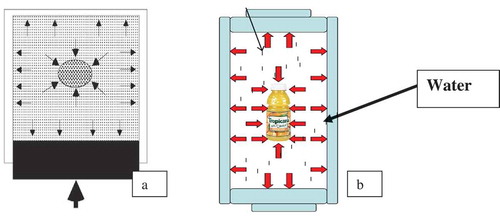
Figure 2. How HPP works: baskets loaded on conveyer.
Source: Raghubeer (Citation2015) (Avure Technologis, USA).
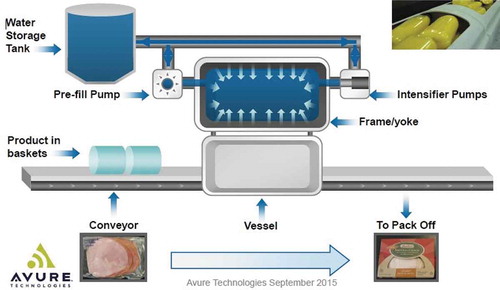
Figure 3. Schematic representation for the temperature and pressure control.
Source: Von and Ardia (Citation2004).

Figure 4. HPP food applications.
Source: Raghubeer (Citation2015) (Avure Technologis, USA).
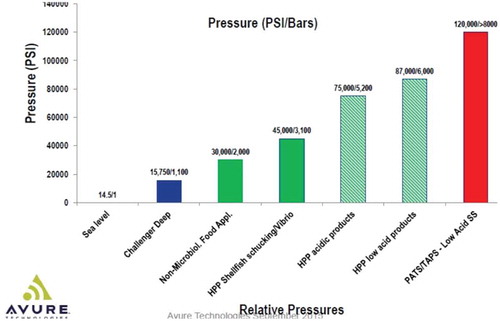
Figure 5. shelf-life extension of macaroni salad with vegetables by HPP (pH 4.83).
Source: Avure Technologies Inc (Citation2009).
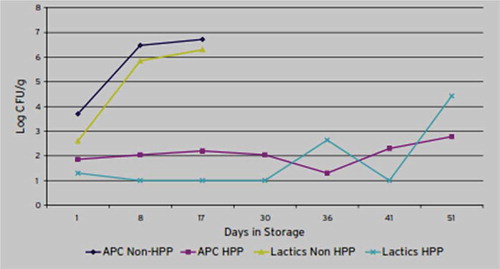
The application of 400, 600, and 900 MPa done to inactivate Listeria monocytogenes, Salmonella enterica and Staphylococcus aureus on five strains resulted in important decreases (>8 log reduction) in the counts of L. monocytogenes to below the detection limit (1 log CFU/ml). No differences were observed among the five strains assayed (P > 0.05). All S. enterica strains, by contrast, were drastically inactivated at 400 MPa (7–8 log unit reduction) but few sub-lethally injured cells (1.0–1.6 log CFU/ml) remained viable. After pressurization at 600 MPa, viable cells were detected only in S. enterica strain S1003 (1.1log CFU/ml, including 0.2 log of sublethally injured cells). Staphylococcus aureus was much more resistant than L. monocytogenes and S. enterica to HP treatments of 400 and 600 MPa (P < 0.05) and the viable counts of the five strains of the pathogen decreased by only 1.5–2.0 log units after treatment at 400 MPa and by 5.8–8log units after treatment at 600 MPa (Jofré et al., Citation2010) (Table ).
The viability of vegetative microorganisms may be affected by inducing structural changes at the cell membrane or by the inactivation of enzyme systems which are responsible for the control of the metabolic actions. Typically, significant inactivation of vegetative bacteria, yeasts and molds viruses can be observed within minutes at room temperature and pressures higher 300 MPa. However, increasing the pressure to 700 MPa or higher most inactivation reactions are strongly accelerated. So far there only a few studies reporting inactivation kinetics of vegetative microorganisms over a wide range of pressure-temperature combinations, a combinations that lead to 5 log reduction of several pathogenic and spoilage organisms within 5 min of treatment. It is generally accepted that pressure and temperature act synergistically on the destruction of vegetative bacteria in the high-temperature domain. Spores of Clostridium botulinum and Bacillus species are the key bacteria for the safety or the spoilage of low acid (heat treated) preserved goods. These spores have shown remarkable tolerance to pressures above 1,000 MPa at room temperature. On the other hand, many other bacterial endospores, which are relevant to food are inactivated at pressures 600 MPa or greater in combination with initial temperature above 60°C (Heinz & Buckow, Citation2009).
According to Sharma (Citation2011), during application of HPP to inactivate the microorganisms in food, there can be microbial that act stability to the action of the HPP treatment. The mechanism of action on inactivating the pathogens is there is breakdown of non-covalent bonds and puncturing or permeabilization of the cell membrane of the pathogens. The HPP treatment is different for different microorganisms, e.g., vegetative cells of the pathogen is ruptured by 300 MPa at room temperature; spore formers by more than 600 MPa at 60–70°C, and some enzymes inactivated by 300 Mpa. There is little effect on inactivating on microorganisms on foods with moisture of below 40%.
According to Pal and Devrani (Citation2018), the tenderization of meat or acceleration of meat conditioning could be induced by high-pressure treatment and the improvement of thermal gel formability of pressurized actomyosin, especially at low salt concentration, opens up the possibility for exploitation of new types of meat products. The shelf life of cooked meat products prepared by conventional methods could be extended by exposing them to high pressure.
2.2.4. Other uses
HPP can also cause changes in milk rennet coagulation properties, produce a more continuous or homogeneous protein matrix in cheese, improve cheese structure, texture and yield, as well as reduce moisture content variations within fresh cheese blocks. Providing HPP can be operated economically, the use of pressure may be an attractive new method for the processing of cheese (Okpala, Piggott, & Schaschke, Citation2009). Application of High hydrostatic pressure was conducted to improve the functionality of dietary fiber in Okara by-product from soybean. The combined effect of high hydrostatic pressure (HHP) and controlled temperature on total (TDF), soluble dietary fiber (SDF) content, and its associated hydration properties were assayed in okara, a rich-in-insoluble dietary fiber residue from the soy drink and tofu-making process of soybean. Okara is the main by-product from soymilk and tofu preparation. Approximately, from 1 kg dry soybean seeds before soaking, 2.5 g fresh okara is obtained. Okara is rich in dietary fiber, mainly as insoluble fiber, besides protein and fat. TDF in starting unprocessed okara was 45.7% and its SDF to TDF ratio was 4.6. When dry, hydrated and autoclaved okara samples, were subjected to HHP-treatment (200 and 400 MPa) at 30°C and 60°C, the amount of SDF went up by more than 8-fold. At 200 MPa, TDF was not significantly different from control, but at 400 MPa values varied from 38.1% to 64.8%. In vitro physicochemical properties of okara were also modified by HHP-treatment. Therefore, the effect of a combined treatment with hydration, temperature and HHP-technology on the improvement of the soluble fiber fraction (%) and functionality of certain vegetable by-products from the food industry could be very useful for the elaboration of food ingredients with potential health-promoting effects. Results suggested that the higher the hydrostatic pressure and temperature applied, the higher the ratio of soluble to total dietary fiber in okara. HPP-treatment could increase the soluble fraction (%) of other rich-in-insoluble dietary fiber vegetable by-products, which could potentially be used as valuable ingredients of new functional foods (Mateos-Aparicio, Mateos-Peinado, & Rupérez, Citation2010).
The effect of HP and heat pretreatments, used prior to drying, on the rehydration rate and quality of sweet potato was investigated by Abe et al. (Citation2011). Sweet potato was pressurized at 200 MPa for 5 min and heat treatment was performed at 100°C for 5 min. Three different types of pretreatments were performed: Heat treatment, heat treatment after HP treatment and HP treatment after heat treatment. Heat treatment after HP treatment resulted in pronounced texture improvement compared to the other pretreatments. The relative hardness of the rehydrated sweet potato exposed to heat treatment after HP treatment was higher than with the other pretreatments (Figure ).
Furthermore, it was found that the rehydration rate of sweet potato exposed to heat treatment after HP treatment was lower than either heat treatment or HP treatment after heat treatment. Heat treatment after HP treatment prior to drying prevented cubes of sweet potato from collapsing during rehydration. Therefore, in sweet potato, the use of heat treatment after HP treatment prior to drying could serve as an effective method for texture improvement (Abe et al., Citation2011) (Figure ).
The effect of high-pressure treatment (200–600 MPa for 20 min) on the texture of cherry tomatoes and on the key softening enzymes (pectin-methylesterase and polygalacturonase) was investigated. When subjected to high-pressure treatment whole cherry tomatoes showed increasing textural damage with increasing pressures up to 400 MPa. However, treatment at pressures above 400 MPa (500–600 MPa) led to less apparent damage than treatment at 300 and 400 MPa; the tomatoes appearing more like the untreated samples. These visual changes were reflected in the texture (firmness) and amount of cell rupture in the tomatoes, with the least firmness and the most cell rupture being seen after treatment at 400 MPa. Polygalacturonase was more susceptible to pressure, being almost totally inactivated after treatment at 500 MPa. Initially, damage is caused by the greater compressibility of the gaseous phase (air) compared to liquid-solid components, giving rise to a compact structure which, on pressure release, is damaged as the air rapidly expands, leading to increases in membrane permeability. This permits egress of water, and the damage also enables enzymatic action to increase, causing further cell damage and softening. The major enzyme involved in the further softening is polygalacturonase, which is inactivated at 500 MPa and above, and not pectinmethylesterase, which in the whole fruit, is barotolerant (Tangwongchai, Ledward,And, & Ames, Citation2000).
2.3. Advantage and challenges
HPP offers an advantage of reduced process times; minimal heat penetration/heat damage problems; freshness, flavor and color are well retained; there is no vitamin C loss, and functionality-alterations are minimized compared with traditional thermal processing (Xu, Citation2005) Avoiding chemical additives or high temperatures so that it fulfills consumer demand, no consumer negativity, e.g., like that of irradiation and GM (Sharma, Citation2011). It Extended shelf life-wider product distribution and results in fewer product returns. Uses less energy (hence greenhouse gases) than other technologies and has the highest processing efficiency for pumpable foods. Processing can be done in final packaging which avoids post-processing contamination and tempering including retail processors (Howson, Citation2009). Required processing times are also reduced and there are no by-products. It also permits the inactivation of microorganisms and enzymes at low temperatures, while valuable low molecular constituents, such as bioactives, vitamins, colors and flavorings, remain largely unaffected (Sharma, Citation2011).
There is Food safety challenge, i.e., Inability of HPP to inactivate spores (Sharma, Citation2011), but other researchers say that HPP can destruct MOs at room temperature or lower, and Enzymes and even spore-forming bacteria can be inactivated by HPP application (Rastogi, Raghavarao, Balasubramaiam, Niranjan, & Knorr, Citation2007). Using Combination of HPP and heat like High-Pressure Sterilization (HPS) or Pressure assisted temperature sterilization (PATS) can be a solution (Sharma, Citation2011). Other key challenges identified include Heat transfer problems and resulting in non-uniformity in processing, obtaining reliable reproducible data for process validation, lack of detailed knowledge about the interaction between high pressure, and a number of food constituents, packaging and statutory issues (Rastogi et al., Citation2007). Therefore, HPP treatment seems to be a better alternative to other traditional techniques such as thermal pasteurization, used to preserve food products (Daher et al., Citation2017)
3. Prospects
Since it is witnessed and proved that application of HPP fulfill the demand of consumers, nutritionally, safety issue healthy and in extending shelf-life of the food, it is a guarantee to the future food industries as well as consumer. It can be seen that it is mostly adapted by developed countries, specifically limited companies like that of Avure Technology. It looks it is a latest and modern technology, but the tremendous role it is playing on the food processing makes it to be widely dispersed throughout the world so that food insecurity and food malnutrition can be history. There is also lack of activity or passive investment from large companies, limited commercial research & innovation, limited consumer awareness of HPP benefits and its application including the safety issue regarding the HPP treated food. So, there must be an active investment from large companies in installing industries wherever possible and as much as they could. Moreover there must be educational efforts in creating consumer awareness. HPP is providing an extended shelf-life of food, retaining the quality indices of the food and trying to eradicate spoiling microorganisms. Appreciating its advantage, the following points should be think-full; Continuous work/research is required on the inactivating of the spore-forming and others like that of Clostridium and Bacillus pathogens; Expansion work on this new technology to other areas of facing product loss due to lack of technology can help at least on consuming the available produce and play role on minimizing the food insecurity; A clear awareness creation on the HPP principle and its application is needed so that it can be adopted. Though it was mentioned that there is a differentiated type of food with its HPP range in some place, the food suitable/unsuitable for HPP and the packaging material of HPP treated food should be clearly put and understood. The consumer acceptance should be considered as well.
Additional information
Funding
Notes on contributors
Gezai Abera
Gezai Abera is fulltime lecturer in the department of Horticulture and Dean of the College of Agriculture and Natural Resource at Raya University. He was working as a lecturer at Samara University, Afar for the last nine years with the duty of Teaching different Horticultural courses and conducting research and community services. Currently, he is teaching courses in the department and involved in research and community works. His research interest focuses are on Postharvest management and technology, food nutrition and food safety, agronomy and production related.
References
- Abe, S., Takimoto, S., Yamamuro, Y., Tau, K., Takenaga, F., Suzuki, K., & Oda, M. (2011). High pressure and heat pretreatment effects on rehydration and quality of sweet potato. American Journal of Food Technology, 6(1), 63–23. ISSN 1557-4571. Academic Journals Inc. Japan. doi: 10.3923/ajft.2011.63.71.
- Adzahan, M. N., & Benchamaporn, P. (2007). Potential of non-thermal processing for food preservation in Southeast Asian countries: Review paper. ASEAN Food Journal, 14(3), 141–152.
- Avure Technologies Inc. (2007). High pressure processing of food. Retrieved from http://www.avure.com/food/applications/default.asp
- Avure Technologies Inc. (2008). High pressure processing of food. Retrieved from http://www.avure.com/food/applications/default.asp
- Avure Technologies Inc. (2009). High pressure processing of wet salads, dips, soups and souces. Application Brief on HPP Technology: Food Safety, Extended Shelf Life and All Natural.
- Balasubramaniam, V. M., & Farkas, D. (2008). High-pressure food processing. Food Science and Technology International, 14(5), 413–418. SAGE Publications: on the behalf Spanish Council for Scientific Research (SCSR). ISSN: 1082-0132. doi:10.1177/1082013208098812
- Basak, S., & Ramaswamy, H. S. (1998). Effect of high pressure processing on the texture of selected fruits and vegetables. Journal of Texture Studies, 29, 587–601. Department of Food Science and Agricultural Chemistry, McGill University, Macdonald Campus Ste-Anne-de Bellevue, Quebec, H9X 3V9 Canada. Trumbull, CT: Food & Nutrition Press.
- Bertucco, A., & Vetter, G. (Eds). (2001). High pressure process technology: Fundamentals and applications: Industrial chemistry (Vol. 9). Amsterdam, The Netherlands: Elsevier Science B. V. d by the consumers. ISBN: 0-444-50498-2.
- Chipurura, B., & Muchuweti, M. (2010). Effect of irradiation and high pressure processing technologies on the bioactive compounds and antioxidant capacities of vegetables. Asian Journal of Clinical Nutrition, 2(4), 190–199. ISSN 1992-1470. Asian Network for Scientic Information. doi:10.3923/ajcn.2010.190.199
- Daher, D., Le Gourrierec, S., & Pérez-Lamela, C. (2017). Effect of high pressure processing on the microbial inactivation in fruit preparations and other vegetable based beverages: Review. MDPI-Agriculture, 7, 72. doi:10.3390/agriculture7090072
- Flick, G. J. (2003, February). High hydrostatic pressure processing has potential: Commercial fish & shellfish technology (CFAST) journal reprint. Originally Appearing in Global Aquaculture Advocate, 6(1). Avure Technologies, Inc.
- Fonberg-Broczek, M., Windyga, B., Szczawinski, J., Szczawinski, M., Pietrzak, D., & Prestamo, G. (2005). High pressure processing for food safety. Acta Biochimica Polonica, 52, 721–724. ISSN: 3/2005.
- Goodner, J. K., Braddock, R. J., & Parish, M. E. (1998). Inactivation of pectinesterase in orange and grapefruit juices by high pressure. Journal of Agricultural Food Chemistry, 46, 1997–2000. Citrus Research and Education Center, University of Florida, 700 Experiment Station Road, Lake Alfred, Florida 33580-2299. Florida: American Chemical Society. doi:10.1021/jf9709111
- Gopal, K. R., Kalla, A. M., & Srikanth, K. (2017). High pressure processing of fruits and vegetable products: A review. International Journal of Pure and Applied Bioscience, 5(5), 680–692. doi:10.18782/2320-7051.2930
- Guangjie, Z. H. A. N., & Bo, S. L. (2000). Effect of ultra-high pressure on the quality and safety of fresh-cut Chinese Yam. China.
- Hayman, M. M., Baxter, I., O’Riordan, P. J., & Stewart, C. M. (2004). Effects of high-pressure processing on the safety, quality, and shelf life of ready-to-eat meats. Journal of Food Protection, 67(8), 1709–1718. Australia. doi:10.4315/0362-028X-67.8.1709
- Heinz, V., & Buckow, R. (2009). Food preservation by high pressure. Journal of Consumer Protection and Food Safety. Basel/Switzerland. doi:10.1007/s00003-009-0311-x
- Howson, G. (2009). High pressure processing for food safety, extended shelf life and all-natural. Avure Technologies, USA.
- IUFoST. (2010). Emerging and new technologies in food science and technology scientific information bulletin (SIB). International Union of Food Science and Technology, India.
- James, I. F., & Kuipers, B. (2003). Preservation of fruit and vegetables (Agrodok 3). Wageningen: Agromisa Foundation.
- Jofré, A., Aymerich, T., Bover-Cid, S., & Garriga, M. (2010). Inactivation and recovery of Listeria monocytogenes, Salmonella enterica and Staphylococcus aureus after high hydrostatic pressure treatments up to 900 Mpa: Research article. International Microbiology, 13, 105–112. ISSN: 1139-6709. doi:10.2436/20.1501.01.115
- Kadam, P. S., Jadhav, B. A., Salve, R. V., & Machewad, G. M. (2012). Review on the high pressure technology (HPT) for food preservation. Journal of Food Processing and Technology, 3, 135. doi:10.4172/2157-7110.1000135
- Kader, A. A. (2008). Fresh-cut mangos as a value-added product (Literature review and interviews).
- Karim, P. A. (2011). High pressure processing as an alternative food preservation technology and its application for fruits and vegetables. Manhattan, KS: Kansas State University.
- Kuldiloke, J., & Eshtiaghi, M. N. (2008). Application of non-thermal processing for preservation of orange juice. KMITL Science and Technology Journal, 8(2). Mahidol University, Nakhornpathom, 73170, Thailand.
- Liplap, P., Vigneault, C., Rennie, T. J., Boutin, J., & Raghavan, G. S. V. (2013). Method for determining the respiration rate of horticultural produce under hyperbaric treatment. Food and Bioprocess Technology. Springer Science+Business, Media New York. doi:10.1007/s11947-013-1183-8
- Mateos-Aparicio, I., Mateos-Peinado, C., & Rupérez, P. (2010). High hydrostatic pressure improves the functionality of dietary fibre in okara by-product from soybean. Innovative Food Science and Emerging Technologies, 11, 445–450. Elsevier Ltd. journal homepage.
- Moreno, S. C., Plaza, L., DeAncos, B., Martin, B. O., & Cano, M. P. (2005). Impact of high pressure and pulsed electric fields on bioactive compounds and antioxidant activity of orange juice in comparison with traditional thermal processing. Journal of Agriculture and Food Chemistry, 53, 4403–4409. Elsevier Ltd. doi: 10.1021/jf048839b
- Murchie, L. W., Cruz-Romero, M., Kerry, J. P., Linton, M., Patterson, M. F., Smiddy, M., & Kelly, A. L. (2005). High pressure processing of shellfish: A review of microbiological and other quality aspects: Review. Innovative Food Science and Emerging Technologies, 6, 257–270. Elsevier.
- Okpala, C. O. R., Piggott, J. R., & Schaschke, C. J. (2009). Effects of high-pressure processing (HPP) on the microbiological, physicochemical and sensory properties of fresh cheeses: A review. African Journal of Biotechnology, 8(25), 7391–7398. ISSN 1684–5315.
- Otero, L., Ramos, A. M., de Elvira, C., & Sanz, P. D. (2007). A model to design high-pressure processes towards an uniform temperature distribution. Journal of Food Engineering, 78(4), 1463–1470. ISSN 0260-8774. Elsievier. doi:10.1016/j.jfoodeng.2006.01.020
- Pal, M., & Devrani, M. (2018). Application of various techniques for meat preservation. Journal of Experimental Food Chemistry, 4, 134. ISSN: 2472-0542. doi: 10.4172/2472-0542.1000134
- Patras, A., Brunton, N., Da Pieve, S., Butler, F., & Downey, G. (2009a). Effect of thermal and high pressure processing on antioxidant activity and instrumental color of tomato and carrot purees. Innovative Food Science and Emerging Technologies, 10, 16–22. doi:10.1016/j.ifset.2008.09.008
- Patras, A., Brunton, N. P., Da Pieve, S., & Butler, F. (2009b). Impact of high pressure processing on total antioxidant activity, phenolic, ascorbic acid, anthocyanin content and colour of strawberry and blackberry purées. Innovative Food Science and Emerging Technologies, 10, 308–313. Elsevier Ltd. All rights reserved. doi: 10.1016/j.ifset.2008.12.004:
- Queiroz, C., Moreira, C. F. F., Lavinas, F. C., Lopes, M. L. M., Fialho, E., & Valente-Mesquita, V. L. (2010). Effect of high hydrostatic pressure on phenolic compounds, ascorbic acid and antioxidant activity in cashew apple juice. High Pressure Research, 30, 507–513. Taylor & Francis Publishing, Mortimer House, 37–41 Mortimer Street, London W1T 3JH, UK.
- Raghubeer, E. V. (2015). High pressure processing of food and beverage. Middletown, OH: Avure Technologies.
- Ramaswamy, H. S., & Tessema, A. (2010, June 17–18). Achieving food security through reduction in postharvest losses of indigenous foods and enhancing manpower training opportunities: Canada-Ethiopia experience. Food Innovation Asia conference 2010: Indigenous food research and development to global market, at BITEC, Bangkok, Thailand, as a part of ProPak Asia 2010.
- Ramaswamy, H. S., Zaman, S. U., & Smith, J. P. (2008). High pressure destruction kinetics of E.coli (O157: H7)and Listeria monocytogenes (Scott A) in a Fish Slurry. Journal of Food Engineering, 87(1), 99–106. ISSN 0260-8774. Elsevier. doi:10.1016/j.jfoodeng.2007.11.017
- Ramirez-Suarez, J. C., & Morrissey, M. T. (2006). Effect of high pressure processing (HPP) on shelf life of albacore tuna (Thunnus alalunga) minced muscle. Innovative Food Science and Emerging Technologies, 7, 19–27. Elsevier Ltd.
- Rastogi, N. K., Raghavarao, K. S. M. S., Balasubramaiam, V. M., Niranjan, K., & Knorr, D. (2007). Opportunities and chanllenges in high pressure processing of foods. Critical Reviews in Food Science and Nutrition, 47(1), 69–112. Taylor and Francis Group. doi:10.1080/10408390600626420
- Särkkä-Tirkkonen, M., Hanna-Maija, V., & Beck, A. (2010). Overview on different sterilization techniques for baby food (Report 60). Ruralia Institute, University of Helsinki, Finland.
- Sharma, R. (2011). Market trends in high pressure processing (HPP) food. Australia: The University of Queensland.
- Tangwongchai, R., Ledward,And, D. A., & Ames, J. M. (2000). Effect of high-pressure treatment on the texture of cherry tomato. Journal of Agriculture and Food Chemistry, 48, 1434–1441. Whiteknights, Reading RG6 6AP, United Kingdom. American Chemical Society. doi:10.1021/jf990796p
- Von, V., & Ardia, A. (2004). Process considerations on the application of high pressure treatment at elevated temperature levels for food preservation. Tag der wissenschaftlichen Aussprache: Berlin. Retrieved from http://citeseerx.ist.psu.edu/viewdoc/download?doi=10.1.1.117.6372&rep=rep1&type=pdf
- Wang, W. D., & Xu, S. Y. (2007). Degradation kinetics of anthocyanins in blackberry juice and concentrate. Journal of Food Engineering, 82, 271–275. doi:10.1016/j.jfoodeng.2007.01.018
- Xu, S. (2005). Studies on the mechanical properties of vegetables processed by high pressure. The Journal of American Science, 1(2). Studies on the Mechanical properties of Vegetables. Food Engineering College, Harbin Commerce University, Harbin, Heilongjiang 150076, China.
- Yaldagard, M., Mortazavi, S. A., & Tabatabaie, F. (2008, August 18). The principles of ultra high pressure technology and its application in food processing/preservation: A review of microbiological and quality aspects. African Journal of Biotechnology, 7(16), 2739–2767. ISSN 1684-5315.
- Yordanov, D. G., & Angelova, G. V. (2010). High pressure processing for food preservation. Biotechnology & Biotechnological Equipment, 24(3), 1940–1945. Plovdiv, Bulgaria. doi:10.2478/V10133-010-0057-8
